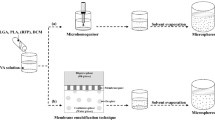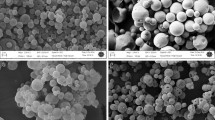Mucoadhesive microspheres of the novel polymer, xyloglucan, have been formulated and their performance characteristics have been systematically evaluated in vitro and in vivo. The mucoadhesive microspheres were obtained by incorporating glipizide as model drug in xyloglucan as a mucoadhesive polymer and sodium alginate as a gel-forming polymer by the orifice-ionic gelation method. A32 factorial design was employed to study the effect of independent variables, xyloglucan concentration (X 1 ) and calcium chloride (CaCl2) concentration (X 2 ), on the dependent variables including drug entrapment efficiency, release time (t 80), and percentage mucoadhesion in 1h. The best batch exhibited high drug entrapment efficiency (92.98%) and percentage mucoadhesion (78% after 1h). The drug release was also controlled for more than 8 hours. In vivo testing of the mucoadhesive microspheres revealed significant hypoglycemic effect of glipizide.







Similar content being viewed by others

References
B. Hannah, Novel Bioadhesive Formulation in Drug Delivery. The Drug Delivery Companies Report (2004), pp. 16 – 19.
J. K. Vasir, K. Tambwekar, and S. Garg, Bioadhesive Microspheres as a Controlled Drug Delivery System, Rev. Int. J. Pharm., 255, 13 – 32 (2003).
C. M. Lehr, J. A. Bouwstra, E. H. Schacht, et al., In vitro Evaluation of Mucoadhesive Properties of Chitosan and Some Other Natural Polymers, Int. J. Pharm, 78, 43 – 48 (1992).
P. S. Rao, T. P. Ghosh, and S. Krishna, Extraction and Purification of Tamarind Seed Polysaccharide, J. Sci. Ind. Res. (India), 4, 705 – 711 (1946).
M. San, E. Miyata, S. Tamano, et al., Lack of Carcinogenicity of Tamarind Seed Polysaccharide in B6C3F Mice, Food Chem. Toxicol., 34, 463 – 467 (1996).
S. Burgalassi, L. Panichi, M. F. Saettone, et al., Development and In Vitro / In Vivo Testing of Mucoadhesive Buccal Patches Releasing Benzydamine and Lidocaine, Int. J. Pharm., 133, 1 – 7 1996).
D. Kulkarni, D. K. Ddwivedi, S. Singh et al., Tamarind Seed Polyose, a Potential Polysaccharide for sustained release of verapamil hydrochloride as a model drug. Indian J. Pharm Sci, 59, 1 – 7 (1997).
M. F. Saettone, S. Burgalassi, B. Giannaccini et al., Ophthalmic Solutions Viscosified with Tamarind Seed Polysaccharide, PCT Int. Appl., 28, 787 (1997).
R. H. Foster and G. L. Plosker, Glipizide: a Review of the Pharmacoeconomic Implications of the Extended-Release Formulation in Type 2 Diabetes Mellitus, Pharmacoeconomics, 18, 289 – 306 (2000).
K. P. R. Chowdary and Y. R. Srinivasan, Design and In Vitro and In Vivo Evaluation of Mucoadhesive Microcapsules of Glipizide for Oral Controlled Release (A Technical Note), AAPS Pharm. Sci. Techol., No. 3, 4 – 9 (2000).
J. K. Patel, R. P. Patel, A. F. Amin, et al., Formulation and Evaluation of Mucoadhesive Glipizide Microspheres, AAPS Pharm. Sci. Technol., No. 6, 49 – 55 (2005).
The United States Pharmacopeia XXVI (The United States Pharmacopoeia Convention, Rockville, MD, 2003), p. 859.
C. M. Lehr, J. Bowstra, J. J. Tukker, et al., Intestinal Transit of Bioadhesive Microspheres in In Situ Loop in Rat, J. Control. Release, 13, 51 – 62 (1990).
J. K. Grover, S. S. Rathi, and V. Vats, Amelioration of Experimental Diabetic neuropathy and Nastropathy in Rats Following Oral Administration of Plant (Eugenia jambolana, Mucurna pruriens and Tinospora cordifolia) Extracts, Indian J. Exp. Biol., 3, 273 (2002).
N. R. Shukla and S. Chanda, Assessment of Polyalthia longifolia Pendula for Hypoglycemic and Antihyperglycemic Activity, J. Clin. Diagn. Res., 3, 116 – 121 (2007).
M. S. Crcarevska, M. G. Dodov, and K. Goracinova, Chitosan Coated Ca-Alginate Microparticles Loaded with Budesonide for Delivery to Inflamed Colonic Mucosa, Eur. J. Pharm. Biopharm., 68, 565 – 578 (2008).
C. R. Kahn and Y. Shechter, in Goodman and Gilman’s The Pharmacological Basis of Therapeutics, McGraw-Hill, New York, NY (1991), p. 1712.
Acknowledgements
The authors are thankful to the Encore Polymer Pvt. Ltd. (Ahmadabad, Gujarat) for kindly providing XG and to the AISSMS College of Pharmacy for kindly providing facilities for carrying out the research project.
Author information
Authors and Affiliations
Corresponding author
Rights and permissions
About this article
Cite this article
Bhalekar, M.R., Patil, K.P., Kshirsagar, S.J. et al. Formulation optimization and in vivo evaluation of mucoadhesive xyloglucan microspheres. Pharm Chem J 45, 503–508 (2011). https://doi.org/10.1007/s11094-011-0665-0
Received:
Published:
Issue Date:
DOI: https://doi.org/10.1007/s11094-011-0665-0



